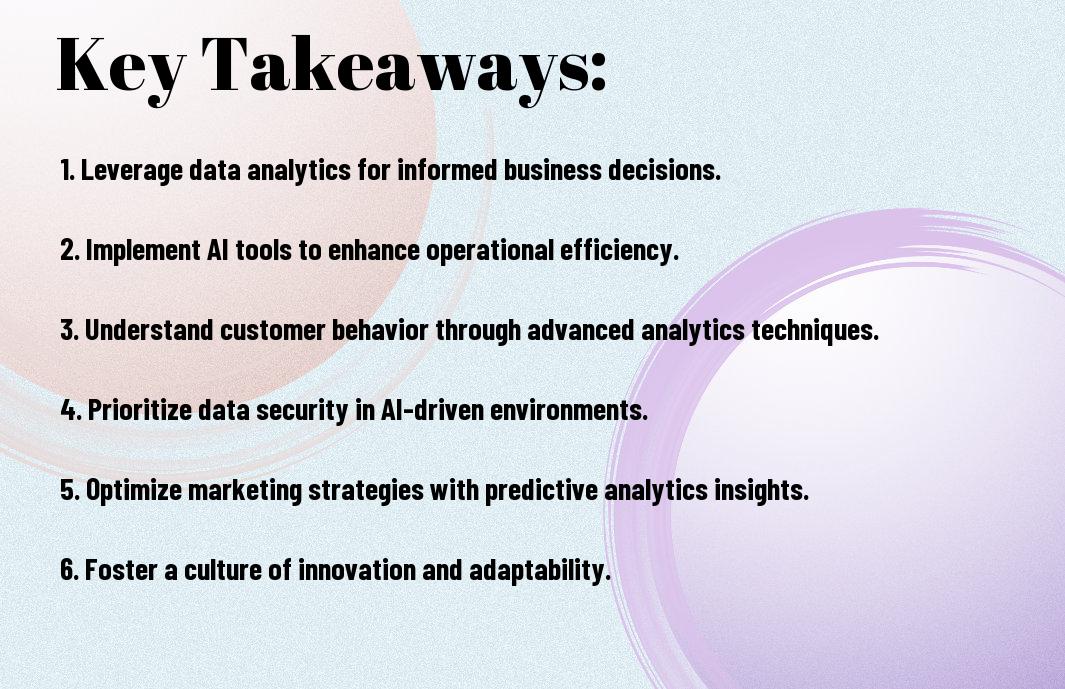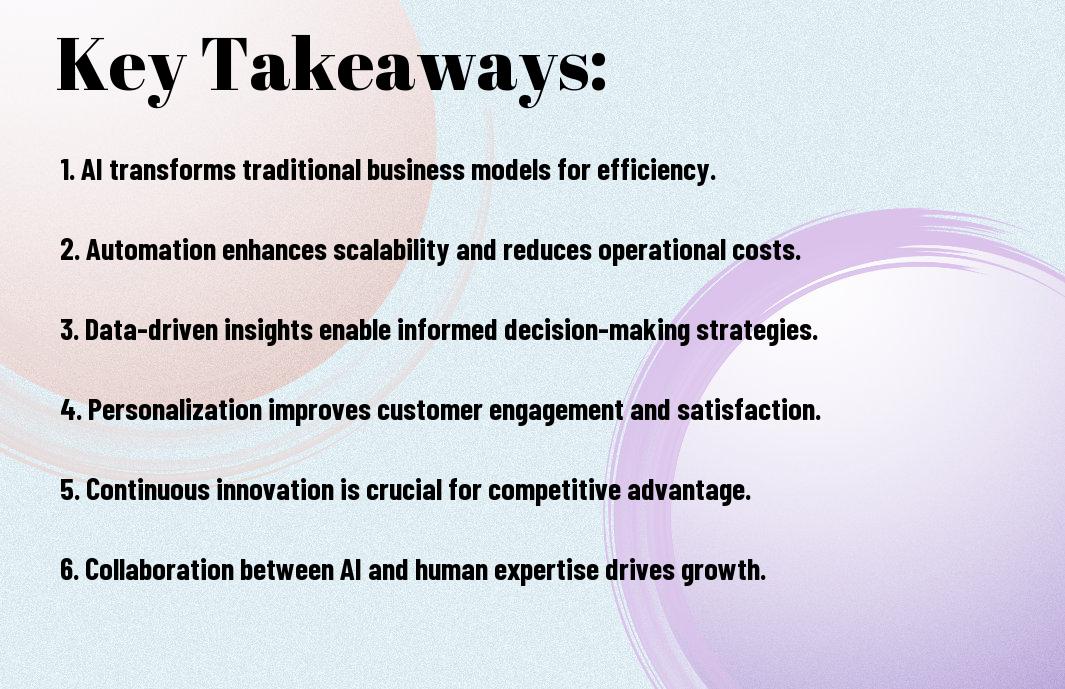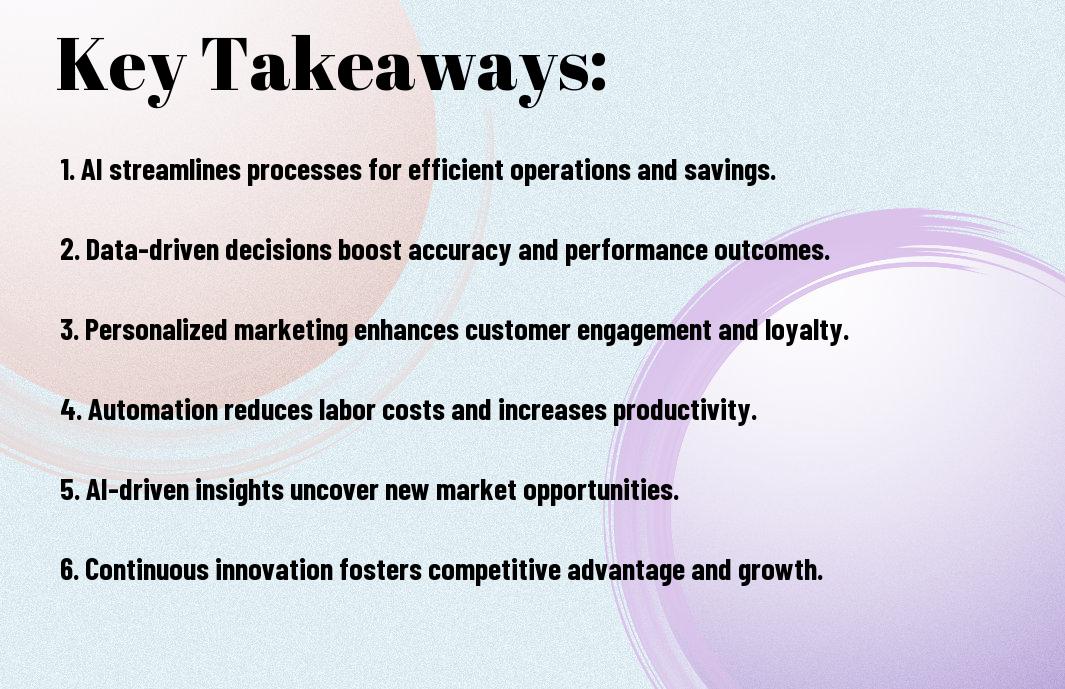As you navigate the complex landscape of modern entrepreneurship, you’re likely aware that making informed decisions is key to driving business growth. Your ability to leverage data and artificial intelligence (AI) will be the defining factor in your success. To stay ahead of the curve, you can explore Data-Driven AI Strategies for Modern Entrepreneurs and discover how to harness the power of AI to boost your bottom line. By doing so, you’ll be well on your way to making smarter, more profitable decisions.
Key Takeaways:
- Leveraging artificial intelligence (AI) can significantly enhance business decision-making by providing entrepreneurs with accurate and timely data analysis, thereby optimizing their strategies and improving outcomes.
- Effective AI integration involves identifying areas where data-driven insights can add the most value, such as marketing, customer service, or operational efficiency, and then implementing AI solutions tailored to those needs.
- By embracing AI, modern entrepreneurs can unlock new revenue streams, reduce costs, and gain a competitive edge in the market, ultimately leading to increased profitability and sustainable growth.
The Data Revolution
A midst the rapid evolution of technology, you’re likely aware that data drives your business decisions, and making informed choices is vital to your success. You can learn more about enhancing your decision-making process by visiting 4 Ways to Improve and Accelerate Your Decision-Making Process to stay ahead.
Harvesting Digital Gold
By leveraging data analytics, you can uncover hidden patterns and trends, giving you a competitive edge in the market, and enabling you to make data-driven decisions that propel your business forward.
Quality Over Quantity
At the heart of effective data analysis lies the ability to distinguish between relevant and irrelevant information, allowing you to focus on the data that truly matters to your business.
Even as you accumulate large amounts of data, you need to prioritize quality over quantity, ensuring that the insights you gain are accurate, reliable, and actionable, ultimately informing your business strategy and driving growth.

Decision Architecture
Some of the most effective entrepreneurs understand the importance of decision architecture in driving business success. You will need to design and implement a decision-making framework that leverages data and AI to inform your choices, ultimately leading to better outcomes for your business.
Algorithmic Thinking
Besides the technical aspects, algorithmic thinking is important for making the most of AI in your decision-making process. You can develop this skill by learning to break down complex problems into manageable parts and identifying patterns in your data, allowing you to make more informed decisions.
Human-AI Collaboration
Only by combining human intuition with AI-driven insights can you unlock the full potential of your decision-making process. You will be able to identify areas where AI can augment your capabilities, freeing you up to focus on high-level strategy and creative problem-solving.
It is worth noting that effective human-AI collaboration requires a deep understanding of your business needs and the capabilities of your AI systems. You will need to carefully consider how to design and implement AI solutions that complement your existing workflows and decision-making processes, ensuring that you are getting the most out of your investment in AI and driving real value for your business.
Dollar Dynamics
Unlike traditional business strategies, AI-driven approaches require a deep understanding of how data informs your financial decisions, ultimately impacting your bottom line. You need to consider how AI can optimize your costs, enhance revenue streams, and drive profitability.
Investment Frameworks
Beneath the surface of AI adoption lies a complex web of investment decisions, and you must navigate these to maximize your returns. You will need to develop a framework that aligns your AI investments with your business objectives, ensuring that every dollar spent generates tangible value.
ROI Calculations
The key to successful AI implementation is measuring the return on investment, and you should approach this with a clear understanding of what metrics to track and analyze. You will need to calculate the ROI of your AI initiatives to ensure they are generating the expected financial benefits.
Investment in AI requires a thorough understanding of how to calculate ROI, as this will help you make informed decisions about where to allocate your resources. You should consider the total cost of ownership, including development, deployment, and maintenance expenses, and weigh these against the anticipated benefits, such as increased efficiency, enhanced customer experience, and improved decision-making. By doing so, you will be able to optimize your AI investments and drive business growth.

Implementation Roadmap
Many entrepreneurs struggle to integrate AI into their business, but with a clear plan, you can overcome this hurdle and start seeing results. Your implementation roadmap should outline key milestones and objectives, ensuring a smooth transition to AI-driven decision making.
First 90 Days
To get started, you will need to assess your current data infrastructure and identify areas where AI can have the most impact, allowing you to prioritize your efforts and allocate resources effectively, helping you to make informed decisions about your business.
Scaling Strategies
After laying the groundwork, you can begin to scale your AI implementation, leveraging machine learning algorithms and data analytics to drive growth and optimization, enabling you to make data-driven decisions that propel your business forward.
This scaling strategy will enable you to continually refine and improve your AI systems, allowing you to stay ahead of the competition and achieve your business goals, as you continue to adapt and evolve your approach to maximize the benefits of AI in your business, and you will be able to measure the effectiveness of your strategy and make adjustments as needed.
Risk Management
Now that you’re leveraging AI in your business, it’s crucial to consider the potential risks involved. You need to assess and mitigate these risks to protect your investments and ensure your business’s success.
Ethical Considerations
With the increasing use of AI, you must consider the ethical implications of your decisions. You should ensure that your AI systems are fair, transparent, and unbiased to maintain your customers’ trust and avoid potential backlash.
Security Protocols
Around the clock, your AI systems are vulnerable to cyber threats. You should implement robust security measures to protect your data and prevent unauthorized access to your systems.
Management of security protocols is an ongoing process that requires your constant attention. You should regularly update your systems, monitor for potential threats, and have a plan in place to respond to security breaches, ensuring the integrity of your data and the trust of your customers.
Competitive Advantage
Keep in mind that your ability to leverage AI will be a key differentiator in the market, setting you apart from competitors and driving business growth.
Market Differentiation
Alongside other strategies, adopting AI solutions allows you to differentiate your business, enhancing your brand and attracting new customers with unique offerings.
Innovation Cycles
Beneath the surface of successful businesses lies a commitment to innovation, with AI driving continuous improvement and informing your strategic decisions.
Advantage lies in your ability to harness AI to accelerate innovation cycles, enabling you to respond quickly to changing market conditions and stay ahead of the competition, as you integrate AI into your business operations and decision-making processes, you will be better positioned to capitalize on new opportunities and drive long-term success.
Summing up
Presently, you have the tools to harness the power of data and AI to drive your business forward. You can make informed decisions, optimize operations, and increase your bottom line. By leveraging AI strategies, you can stay ahead of the competition and achieve your goals. Your ability to adapt and innovate will be key to your success, and with the right approach, you can unlock new opportunities and drive growth in your business.
FAQ
Q: What is the main focus of the book “Data, Decisions, and Dollars – AI Strategies for the Modern Entrepreneur”?
A: The book “Data, Decisions, and Dollars – AI Strategies for the Modern Entrepreneur” primarily focuses on providing entrepreneurs with practical strategies and insights on how to leverage artificial intelligence (AI) and data-driven decision-making to drive business growth and success in the modern era. It explores the intersection of data analysis, AI technologies, and business strategy to help entrepreneurs make informed decisions that positively impact their bottom line.
Q: How can AI strategies benefit small businesses and startups?
A: AI strategies can significantly benefit small businesses and startups by enhancing operational efficiency, improving customer service, and facilitating data-driven decision-making. AI can automate routine tasks, analyze large datasets to provide actionable insights, and help in personalizing customer experiences. This can lead to increased productivity, better customer satisfaction, and ultimately, higher revenue for small businesses and startups.
Q: What kind of data should entrepreneurs focus on to make effective decisions?
A: Entrepreneurs should focus on collecting and analyzing relevant, high-quality data that aligns with their business objectives. This includes customer data, market trends, operational metrics, and financial performance indicators. By analyzing these datasets, entrepreneurs can gain valuable insights into customer behavior, market demands, operational efficiencies, and financial health, enabling them to make informed, strategic decisions that drive business growth.
Q: How can entrepreneurs integrate AI into their existing business models without significant disruption?
A: Entrepreneurs can integrate AI into their existing business models by starting with small, targeted pilot projects that address specific business challenges or opportunities. This approach allows them to test AI solutions, assess their impact, and scale up gradually. Additionally, collaborating with AI experts, investing in employee training, and adopting a flexible, adaptive mindset can help entrepreneurs seamlessly integrate AI into their operations without causing significant disruption.
Q: What are the potential risks and challenges that entrepreneurs should be aware of when implementing AI strategies?
A: When implementing AI strategies, entrepreneurs should be aware of potential risks and challenges such as data privacy and security concerns, ethical considerations, dependency on technology, and the need for continuous updating and maintenance of AI systems. Moreover, ensuring transparency, fairness, and accountability in AI decision-making processes is necessary. By understanding these challenges, entrepreneurs can proactively develop strategies to mitigate risks and ensure the successful adoption of AI within their businesses.











